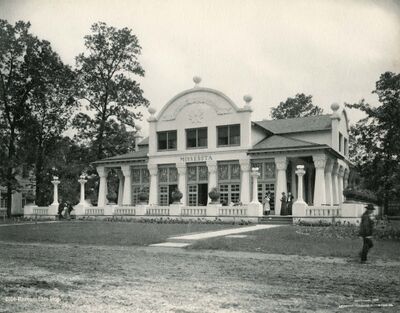Minnesota
 | |
| Location | Plateau of States |
|---|---|
| Construction | |
| Construction Cost | $17,372 ($523,927 in 2021) |
| Architecture | |
| Architect | Reed & Stem, of St. Paul |
| Dimensions | 90' x 110' |
An imposing structure of the Byzantine style, two stories high and represents Minnesota on the Plateau of States.
Description[edit | edit source]
The location gave it added prominence, as it was near the southeast entrance, one of the most convenient for visitors, close to the Inside Inn, and with the Massachusetts, New York, Iowa, and Kansas buildings as neighbors.
A terraced garden surrounds three sides of the building, upon which fronts the main reception room.
It was designed for a southern climate. The entire lower floor could be thrown open by means of large glass doors opening upon corridors and a wide promenade, which was protected by awnings. It was decorated with staff ornaments inside and out, and had burlap paneled ceilings.
Inside, the state building included a reception room 30 by 50 feet in size, with reading tables, the files of the State papers, a post-office, check room, and superintendent's office. Stained glass transoms, in which the names of the eighty-four counties of the State are worked out, top each window.
In the center is the entrance to one of the most unique dining-rooms of the Plateau. It is a dining-room without a kitchen, intended for visitors from the State who bring their luncheons with them. There are comfortable chairs and clean topped tables, and a hearty welcome for the wayfarer.
A men's room and a women's room, each 20 by 20 feet, opened from the rear of the reception room. Two Conover pianos were free for the use of guests, and were a much-appreciated feature. Every possible convenience was afforded to visitors.
Suites for commissioners occupied the second floor.
There the furniture, with its pinned joints and burnt leather and copper trimmings, was made by Manual Training School children of Minneapolis. From the same school came the famous "McKinley Table" used at the national conventions of the Republican party. On it the gavels of presiding officers at conventions which twice nominated William McKinley and once Theodore Roosevelt for the Presidency, rapped for order.
That the general public, as well as visitors from Minnesota, appreciated the building was shown by the hundreds who visited it daily and the many who came day after day to write letters, read the papers, or merely to rest and enjoy its coolness.
In the Palace of Agriculture, the state was fortunate in its location, as it was on one of the large central aisles and adjoining the great glass butter refrigerator, where were shown all the competing fancy butter exhibits from the various states. On an eight-faced glass refrigerator; it was 8 x 10 feet by 15 feet high, contained a huge statue in butter of he statue in butter of a mother giving to her little boy, who stood at her side, a piece of bread and butter, up atop a pedestal and state seal. Nearly a ton of the best creamery butter made in this exhibit.
In another refrigerated container, a 8 by 16 feet representation of Father Hennepin discovering St. Anthonys Falls was also sculpted in butter.
In the Palace of Horticulture, after a new harvest, the state exhibited a Dutch windmill and tower, done entirely in apples.
Minnesota had a credible exhibit of cattle, horses, and swine.
Minnesota had a sizeable exhibits at the Palaces of Mines and Metallurgy Forestry, Fish and Game (tanks of fresh-water fish), and Education as well.
